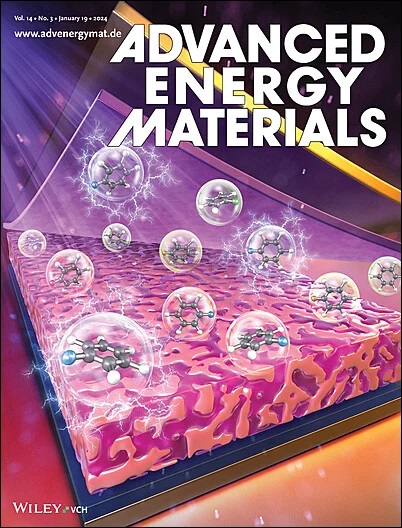Engineered Sodium Metal Anodes: Tackling Sulfur-Derivative Challenges for Advanced Sodium–Sulfur Batteries
IF 24.4
1区 材料科学
Q1 CHEMISTRY, PHYSICAL
引用次数: 0
Abstract
The development of room temperature sodium–sulfur (RT Na─S) batteries has been significantly constrained by the dissolution/shuttle of sulfur-derivatives and the instability of sodium anode. This study presents an engineered sodium metal anode (NBS), featuring sodium bromide (NaBr) along with sodiophilic components like tin metal (Sn) and sodium-tin (Na─Sn) alloy. This configuration exhibits high plating/stripping reversibility with minimal nucleation/growth barriers in an ester-based electrolyte, allowing stable cycling of symmetric cells at 2 mA cm⁻2/2 mA h cm⁻2 for over 2000 h at a low overpotential of 30 mV. Importantly, the weak adsorption and reduced electron transfer towards sulfur-derivatives, along with the facile dissociation of Na2S2/Na2S, effectively minimize the accumulation of sulfur-derivatives, thereby improving the interfacial stability of the NBS electrode in sulfur-derivatives-involved conditions. As a result, the NBS anode endows the Na─S full cells paired with either a Co-NMCN@S or SPAN cathode superior electrochemical performance, with the SPAN//NBS system delivering an outstanding reversible capacity of 1639.5 mA h g⁻¹ and a low degradation rate of 0.06% per cycle at 0.5C. This study elucidates the complex deposition/dissolution kinetics and interface chemistry associated with sulfur species, providing valuable insights for enhancing sodium anodes in practical RT Na─S systems.

工程金属钠阳极:应对先进钠硫电池的硫衍生挑战
室温钠硫(RT Na─S)电池的开发一直受到硫衍生物溶解/钝化和钠阳极不稳定的严重制约。本研究提出了一种工程钠金属阳极 (NBS),以溴化钠 (NaBr) 为特征,同时加入了锡金属 (Sn) 和钠锡 (Na─Sn) 合金等亲钠成分。这种结构在酯基电解质中具有极高的电镀/剥离可逆性,成核/生长障碍极小,可使对称电池在 2 mA cm-2/2 mA h cm-2 的条件下以 30 mV 的低过电位稳定循环超过 2000 小时。重要的是,NBS 电极对硫衍生物的吸附力弱,电子传递减少,Na2S2/Na2S 易于解离,这些都有效地减少了硫衍生物的积累,从而提高了 NBS 电极在硫衍生物参与条件下的界面稳定性。因此,NBS 阳极赋予了与 Co-NMCN@S 或 SPAN 阴极配对的 Na─S 全电池卓越的电化学性能,SPAN//NBS 系统的可逆容量高达 1639.5 mA h g-¹,在 0.5C 下的降解率低至每周期 0.06%。这项研究阐明了与硫物种相关的复杂沉积/溶解动力学和界面化学,为增强实用 RT Na─S 系统中的钠阳极提供了宝贵的见解。
本文章由计算机程序翻译,如有差异,请以英文原文为准。
求助全文
约1分钟内获得全文
求助全文
来源期刊

Advanced Energy Materials
CHEMISTRY, PHYSICAL-ENERGY & FUELS
CiteScore
41.90
自引率
4.00%
发文量
889
审稿时长
1.4 months
期刊介绍:
Established in 2011, Advanced Energy Materials is an international, interdisciplinary, English-language journal that focuses on materials used in energy harvesting, conversion, and storage. It is regarded as a top-quality journal alongside Advanced Materials, Advanced Functional Materials, and Small.
With a 2022 Impact Factor of 27.8, Advanced Energy Materials is considered a prime source for the best energy-related research. The journal covers a wide range of topics in energy-related research, including organic and inorganic photovoltaics, batteries and supercapacitors, fuel cells, hydrogen generation and storage, thermoelectrics, water splitting and photocatalysis, solar fuels and thermosolar power, magnetocalorics, and piezoelectronics.
The readership of Advanced Energy Materials includes materials scientists, chemists, physicists, and engineers in both academia and industry. The journal is indexed in various databases and collections, such as Advanced Technologies & Aerospace Database, FIZ Karlsruhe, INSPEC (IET), Science Citation Index Expanded, Technology Collection, and Web of Science, among others.
 求助内容:
求助内容: 应助结果提醒方式:
应助结果提醒方式:


